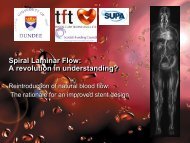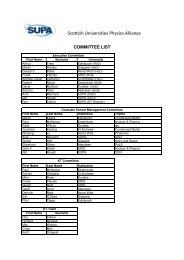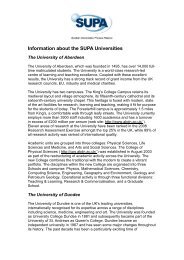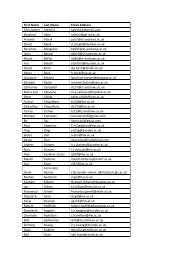Catalogue of Courses & Student Handbook - SUPA
Catalogue of Courses & Student Handbook - SUPA
Catalogue of Courses & Student Handbook - SUPA
Create successful ePaper yourself
Turn your PDF publications into a flip-book with our unique Google optimized e-Paper software.
Astronomy and Space Physics<br />
Semester 1<br />
The Astronomy and Space Physics courses cover a broad range <strong>of</strong><br />
topics aimed at widening students’ knowledge <strong>of</strong> the field. They range<br />
from advanced extensions <strong>of</strong> subjects covered at undergraduate level<br />
to the introduction <strong>of</strong> new interdisciplinary sciences. We recommend that<br />
students take a mixture <strong>of</strong> core material, advanced courses (usually<br />
16-20 hours equivalent credit) and more general topics, including<br />
computing and data reduction modules, to gain a broad grounding<br />
in astronomical methods and modern research areas.<br />
Each course is self-contained, although background reading or another<br />
<strong>SUPA</strong> course may be recommended to bring students from various<br />
backgrounds up to speed. <strong>Student</strong>s from other theme areas are very<br />
welcome to take Astronomy and Space Physics courses, with particular<br />
modules likely to be <strong>of</strong> interest for Life Sciences and Plasma Physics<br />
students, but they should remember that a basic understanding <strong>of</strong><br />
astronomy and astronomical terms will be assumed by course lecturers.<br />
A typical programme, building to the core<br />
requirement <strong>of</strong> 40 hours <strong>of</strong> Technical <strong>Courses</strong><br />
might include:<br />
• A <strong>SUPA</strong> technical Astronomy course (these generally constitute<br />
16-20 hours)<br />
• A technical <strong>SUPA</strong> course in another field or a second Astronomy<br />
course<br />
• Non-<strong>SUPA</strong> courses as appropriate (e.g., for students changing<br />
specialities)<br />
• Summer Schools in Astronomy and Space Physics<br />
Astronomy students should note that certain Astronomy courses are<br />
only run biennially. Each student must consult their PhD supervisor to<br />
construct a suitable programme before registering, and students are<br />
encouraged not to over-register. The 40 hour course requirement is<br />
taken over the first and second years, although students from all<br />
years can take extra subjects for interest.<br />
Advanced Data Analysis - Astronomy (<strong>SUPA</strong>AAA)<br />
Lecturer: Keith Horne<br />
Institution: St Andrews<br />
Hours Equivalent Credit: 20<br />
Assessment: Continuous Assessment<br />
This is a final year undergraduate course organised by the University<br />
<strong>of</strong> St Andrews<br />
Course Description<br />
This module develops an understanding <strong>of</strong> basic concepts and <strong>of</strong>fers<br />
practical experience with the techniques <strong>of</strong> quantitative data analysis.<br />
Beginning with fundamental concepts <strong>of</strong> probability theory and random<br />
variables, practical techniques are developed for using quantitative<br />
observational data to answer questions and test hypotheses about<br />
models <strong>of</strong> the physical world. The methods are illustrated by applications<br />
to the analysis <strong>of</strong> timeseries, imaging, spectroscopy, and tomography<br />
data sets. <strong>Student</strong>s develop their computer programming skills, acquire<br />
a data analysis toolkit, and gain practical experience by analysing real<br />
data sets.<br />
Gravitational Wave Detection (<strong>SUPA</strong>GWD)<br />
Lecturer: Giles Hammond<br />
Institution: Glasgow<br />
Hours Equivalent Credit: 15<br />
Assessment: Essay and Viva<br />
Course Description<br />
This course is for students interested in the physics <strong>of</strong> gravitational<br />
wave detection. Starting from the fundamentals <strong>of</strong> Einstein’s General<br />
Theory <strong>of</strong> Relativity, the wave nature <strong>of</strong> weak field spacetime curvature<br />
perturbations will be derived in the transverse traceless gauge.<br />
Interactions <strong>of</strong> gravitational radiation with matter will be explored,<br />
leading to the basic principles <strong>of</strong> gravitational wave detectors.<br />
Astrophysical sources <strong>of</strong> gravitational waves will be discussed, including<br />
expectations for source strengths from coalescing compact binary<br />
systems, pulsars, etc. A full description <strong>of</strong> currently operating detectors<br />
will include instrumental noise sources, such as thermal, seismic, optical,<br />
and the standard quantum limit. Current topics discussed will include<br />
squeezing, and other non-classical light techniques for reducing optical<br />
noise in interferometric systems. Plans for detectors on the ground and<br />
in space will be presented, ending with a discussion <strong>of</strong> data analysis<br />
techniques.<br />
Assessment Method: A dissertation (or design study), <strong>of</strong> approximately<br />
2000 words, on a current topic in gravitational wave research, to be<br />
submitted at the end <strong>of</strong> the course. Example topics include: thermal<br />
noise reduction, applications <strong>of</strong> non-classical light techniques,<br />
applications <strong>of</strong> optimal filtering techniques, applications <strong>of</strong> Bayesian<br />
inference in data analysis, astrophysical applications <strong>of</strong> gravitational<br />
wave sources. A twenty minute oral exam is also required for each<br />
student at the end <strong>of</strong> the course. Equal weighting will be given to the<br />
two assessment areas.<br />
9







